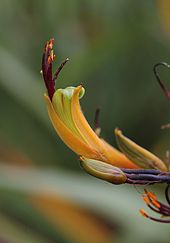- Phormium cookianum
-
Phormium cookianum 
Mountain flax being visited by a tui Scientific classification 
Kingdom: Plantae clade: Angiosperms clade: Monocots Order: Asparagales Family: Xanthorrhoeaceae Subfamily: Hemerocallidoideae Genus: Phormium Species: P. cookianum Binomial name Phormium cookianum
Le Jol.[1]Synonyms Phormium colensoi Hook. f.
Phormium forsterianum Colenso ex Hook.Phormium cookianum (mountain flax or wharariki in Māori ) is a perennial plant that is native to New Zealand.[2] It is less common than the other Phormium species, P.tenax. The greenish, yellow or orange flowers are followed by twisted seed pods.[2]
Contents
Description
The leaves are under 2 metres in length while those of P. tenax range from 1 to 3 metres in length.[3] The scape is much shorter than that of P. tenax, rising up to 2 metres in height while that of P. tenax is around 5 metres in height.[3] The colour of the inner tepals is green while the outer tepals are yellow to red.[3] In contrast the tepals of P. tenax are a dull red, with the tips of the inner tepals being less strongly recurved.[3] The capsules of P. cookianum, unlike those of P. tenax are twisted and pendulous, and may be twice as long (up to 20 cm in length).[3]
Phormium cookianum has two distinct geographic forms, one occurring in lowland parts of the North Island, and the other in the southern and mountainous areas of the South Island as well as ranges in the North Island. The lowland form has green or yellow tepals and the mountain form has red tepals.[3] In the Cook Strait area, both forms and intermediates can be found.[3]
Taxonomy
The species was originally mentioned without description by William Colenso in 1844 in the London Journal of Botany, the name given as Phormium forsterianum.[4] From about 1846 the species was known as P. colensoi, a name that was not published until 1848 by J.D. Hooker in Handbook of the New Zealand Flora.[4] Earlier in the year however, Le Jolis had published the species as P. cookianum.[4] Another specimen, believed to be identical to a plant found by Ronald Gunn at the Waitangi River in 1864, was described from a plant growing in a garden in Torquay, England was given the name P. hookeri.[4]
Cultivars
A number of forms of this species have been selected for cultivation including:
- 'Black Adder' [5]
- 'Cream Delight', a variety derived from P. cookianum subsp. hookeri[5]
- 'Dark Delight' has deep-red leaves up to 1.2 metres in length[6]
- 'Duet' , a dwarf variety up to 30 cm in height with cream and green variegated foliage[6]
- 'Flamingo' [5]
- 'Golden Wonder' [5]
- 'Maori Maiden' (also known as 'Rainbow Maiden') , an erect growing variety with leaves to 1 metre in length with bronze stripes.[6]
- 'Sundowner', a variety with very long leaves which are up to 1.8 metres long. These have a purple centre and cream edges.[6]
- 'Tricolor', an upright variety that has leaves with red, yellow and green stripes. The flowers are pale yellowish-green.[6] It is derived from P. cookianum subsp. hookeri.[5]
There is also a dwarf cultivar, and hybrid cultivars have been selected from crosses with Phormium tenax [5] P. cookianum cultivars are regarded as less hardy than other Phormium cultivars.[7]
Uses
A number of traditional cultivars have been used by the Māori for various purposes:
- Wharariki - a variety from Urewera has a superior fibre quality that may be woven into a soft kete (traditional Māori basket). It has a slight yellow colouration when dried. Another variety from Tairāwhiti is suitable for soft baskets, rorou and toys.[8]
- Whakaari - a variety with leaves suitable for weaving ketes, but less suitable than other cultivars for piupiu (Māori skirts). The leaves have strong blades and dry naturally to a deep green colour, or to a pale greenish-fawn after being boiled for a minute.[8]
See also
- Phormium, covering both species
References
- ^ "Taxon: Phormium cookianum Le Jol.". Germplasm Resources Information Network (GRIN). United States Department of Agriculture, Agricultural Research Service, Beltsville Area. http://www.ars-grin.gov/cgi-bin/npgs/html/tax_search.pl?Phormium+cookianum. Retrieved 2009-01-25.
- ^ a b "Harakeke/flax". Department of Conversation. http://www.doc.govt.nz/conservation/native-plants/harakeke-flax. Retrieved 2009-01-25.
- ^ a b c d e f g Wardle, P. (1979). "Variation in Phormium cookianum (Agavaceae)". New Zealand Journal of Botany 17: 189–196. http://www.royalsociety.org.nz/publications/journals/nzjb/1979/018/. Retrieved 2011-05-08.
- ^ a b c d "P. cookianum". Landcare Research. http://floraseries.landcareresearch.co.nz/pages/Taxon.aspx?id=_b9eb06bb-671a-4161-9f1d-af23650b1782&fileName=Flora%202.xml#_b9eb06bb-671a-4161-9f1d-af23650b1782. Retrieved 2009-01-28.
- ^ a b c d e f "RHS Plant Finder". Royal Horticultural Society. http://www.rhs.org.uk/rhsplantfinder/plantfinder2.asp?crit=phormium%20and%20cookianum. Retrieved 2009-01-28.
- ^ a b c d e Turner, R.G. (1999). Botanica. Barnes & Noble Pty Ltd. ISBN 0760716420.
- ^ "Phormium cultivation". Fernwood Nursery. http://www.fernwood-nursery.co.uk/phormium/2phcultiv.htm. Retrieved 2009-01-28.
- ^ a b "Harakeke weaving varieties – complete list of cultivars in the Rene Orchison collection". Landcare Research. http://www.landcareresearch.co.nz/research/biosystematics/plants/harakeke/all_cultivars.asp. Retrieved 2009-01-28.
Categories:- Hemerocallidoideae
- Flora of New Zealand
Wikimedia Foundation. 2010.

